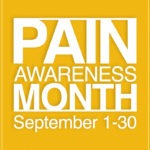September is National Pain Awareness Month
 Over 100 million Americans experience chronic pain – affecting more people than diabetes, heart disease, and cancer combined, according to a recent Institute of Medicine report. Living with pain can be debilitating and affect your everyday life. Understanding more about the underlying causes of pain can help improve treatments and alleviate suffering.
Over 100 million Americans experience chronic pain – affecting more people than diabetes, heart disease, and cancer combined, according to a recent Institute of Medicine report. Living with pain can be debilitating and affect your everyday life. Understanding more about the underlying causes of pain can help improve treatments and alleviate suffering.
With the right knowledge, treatment, and support, chronic and acute pain sufferers can reduce their pain and reclaim their lives. Pain Awareness Month started in 2001 by Partners for Understanding Pain, a consortium of more than 50 organizations that have an interest in pain and its effects. According to recent surveys and research performed by Partners for Understanding Pain, most people in the US are misinformed about this chronic disease. In an effort to bring awareness this month, we have provided 10 facts about pain below.
10 Must-Know Facts About Pain
1. Pain is the most common cause of disability in the United States.

Pain causes more disability than cancer and heart disease combined (National Medical Association). The number of sufferers is also higher than cancer and heart disease, with 100 million Americans suffering from chronic pain (Institute of Medicine), 25.8 million American suffering from diabetes (American Diabetes Association), 16.3 million American suffering from coronary heart disease (American Heart Association) and 11.0 million Americans suffering from cancer (American Cancer Society).
2. Attitude can affect pain.
An associate professor of medicine at Oregon Health and Science University found that those who focus on their pain tend to do poorly compared with those who have a proactive attitude and try to find ways to cope with their pain. Counseling is often recommended to help cope with the pain, especially because pain can often lead to anxiety and depression.
3. Pain personally affects one in three people.

Specifically, more than 50 million Americans suffer from chronic pain each year and another 25 million experience acute pain caused by injury or surgery. Anyone can develop chronic pain, and 80 percent of those who have chronic pain are in the adult 24 to 64 age group. (Partners for Understanding Pain survey).
4. Women feel more pain.
A 2005 study conducted by psychologists at the University of Bath found that women report more pain throughout their lifetimes and, compared with men, they feel more pain in more areas of the body. However, men and women tolerate pain differently. Women use more coping mechanisms to deal with pain, seek treatment more quickly and tend to recover from pain faster than men.
5. Pain is costly.

Pain costs $100 billion annually in lost workdays, medical expenses and other benefit costs. (National Institute for Occupational Safety and Health). Pain is a significant public health problem that costs society at least $560-$635 billon annually, an amount equal to about $2,000 for everyone living in the US (Institute of Medicine Report).
6. Pain is the number 2 top cause for family doctor visits.
Besides the common cold, back pain is the number one reason people visit their family doctors (US National Library of Medicine). According to a 2003 survey for Research! America, most pain sufferers (63%) have seen their family doctor for help, while 40 percent made an appointment with a specialist, such as an orthopedist or chiropractor.
7. Pain affects the workforce.

Workers lose an average of 4.6 hours per week of productive time due to a pain condition. According to data from the American Productivity Audit, 52% of the 28,902 workers surveyed reported having a headache, back pain, arthritis, or other musculoskeletal pain in the past two weeks. Lost productive time from common painful conditions was estimated to be $61.2 billion per year, while 77% of the lost productive time was explained by reduced work performance, not absenteeism.
8. Smoking can increase pain.
Studies show that smoking increases your risk of back pain, and it’s also shown to increase chronic pain in people with fibromyalgia and neck pain. Recent evidence suggests that chronic pain is even more prevalent among former smokers than it is among those who have never smoked. In addition, smokers with chronic pain indicate that their pain is more intense than that of nonsmokers (Mayo Clinic).
9. Pain affects sleep.

An estimated 20 percent of American adults report that pain or discomfort disrupts their sleep a few nights a week or more. Lack of sleep interferes with your mood, activities, relationships and quality of life. According to a recent survey, 50% of those with chronic pain say sleep difficulties has interfered with work. Those with chronic pain reported having 42 minutes of daily sleep debt and those with acute pain reported having 14 minutes of daily sleep debt (National Sleep Foundation).
10. Weather can affect pain.
Changes in barometric pressure can cause some people, especially those with arthritis, to have increased pain in their joints. Experts believe the change in barometric pressure affects joint pressure.
There are many forms of acute and chronic pain and many forms of treatment available. This month, help create awareness and educate citizens about the advanced treatment options available to help alleviate pain.
If you or someone you know is living with pain, feel free to contact Reinhardt Chiropractic by scheduling an appointment or giving us a call at 303-996-0381 to let us help you find some relief.
Recent Post
Managing Stress and Tension: How Chiropractic Care Can Help
July 1, 2024
In our fast-paced world, stress and tension have become ever-present. Whether it’s the demands of work, family responsibilities, or the challenges of everyday life, many of us are constantly battling stress. At Reinhardt Chiropractic, we believe in a holistic approach to health that addresses not only physical pain but also the underlying stress that can
Read More…
Understanding the Benefits of Chiropractic Care for Athletes: Enhancing Performance and Preventing Injuries
June 1, 2024
In the world of sports, athletes are always seeking ways to improve their performance and prevent injuries. One often overlooked yet highly effective method is chiropractic care. At Reinhardt Chiropractic, we understand the unique demands placed on athletes and how chiropractic care can be a game-changer in their training and recovery regimes. Enhancing Performance Improved
Read More…

